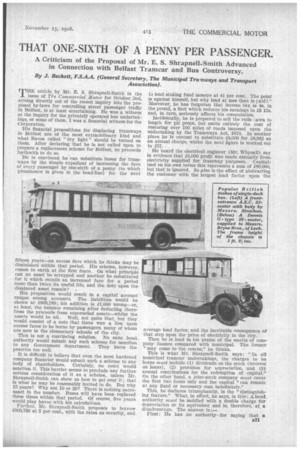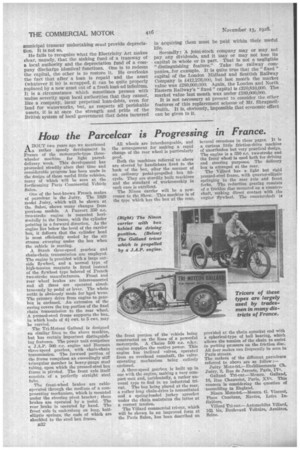THAT ONE-SIXTH OF A PENNY PER PASSENGER.
Page 15

Page 16

If you've noticed an error in this article please click here to report it so we can fix it.
A Criticism of the Proposal of Mr. E. S. Shrapnell-Smith Advanced in Connection with Belfast Tramcar and Bus Controversy.
By J. Beckett, F.S.A.A. (General Secretary, The Municipal Tramways and Transport Association).
THE article by Mr. E. S. Shrapnell-Smith in the issue of Tke •Commercial Meter for October 2nd, arising directly out of the recent inquiry into the proposed by-laws for controlling, street passenger traffic in Belfast, is at least entertaining. He was a witness at the inquiry for the privately operated bus undertakings, or some of them. I was a financial witness for the Corporation.
His financial propositions for •displacing tramways in Belfast are of the most extraordinary kind and what Bacon called "dry light" should be turned on them. After declaring that he is not called upon to prepare a replacement scheme for Belfast, he proceeds forthwith to do so.
He is convinced he can substitute buses for tramways by the simple expedient of increasing the fare of every passenger by one-sixth• of a penny (to which prominence is given in the head-line) for the next fifteen years—an excess fare which he thinks may be diminished within that period. His scheme, •however, comes to earth at the first fence. On what principle can an asset be scrapped and another be substituted for it which entails an increased fare for a period more than twice its useful life, and the debt upon the displaced asset remain? .
His proposition would result in a capital' account unique among accounts. The liabilities would be shown at £803,780; his addition is £1,000 wrong—or, at least, the balance remaining after deducting therefrom the proceeds from superseded assets—whilst the assets would be nil. Well, not quite that, but they would consist of a note that there was a lien upon excess fares to be borne by passengers, ninny of whom are now in the elementary schools of the city.
This is not a convincing solution. No sane local authority would submit any such scheme for sanction to any Government department. They know the practice too well.
It is difficult to believe that even the most hardened company financier would submit such a scheme to any body of shareholders. Certainly, no court would sanction it. This barrier seems to preclude any further serious consideration of it as a scheme, unless Mr. Shrapnell-Smith can show us how to get over it; that is what he may be reasonably invited to do. But why 15 years? Why not 10 or 20? There is nothing sacrosanct In the number. Buses will have been replaced three times within that period. Of course, five years would play havoc with his calculations.
Further, Mr. Shrapnell-Smith proposes to borrow £803,780 at 5 per cent., with the rates as security, and to lend sinking fund moneys at 41 per cent. The point is against himself, but why lend at less than is raid?" Moreeiver, he has forgotten that income tax is 4s. in the pound, a fact which reduces his earnings to 13 12s. and, in turn, seriously affects his computation. , Incidentally, he is prepared to sell the rails sawn to length for pit props, but omits entirely the cost of restoring over 100 miles of roads imposed upon the undertaking by the Tramways Act, 1870. In another place he is content to substitute /8,000 for .£8,902 as an annual charge, 'whilst the next figure is worked out to £57.
• He heard the electrical engineer (Mr. Whysall) say in evidefice that £4,000 profit was.made annually from electricity supplied for tramway purposes. Capitals ized on his own terms this represents a sum of £80,000, but that is ignored. So also is the effect of abstracting the customer with the largest load factor upon the average load factor, and the inevitable consequence of that step upon the price of electricity in the city, Then he is loud in his praise of the merits of company finance compared with municipal. The former " may come to the rescue," he thinks. This is what Mr. Shrapnell-Smith says: "In all municipal tramcar undertakings, the charges to be borne must include (1) dividends on the stock (interest on loans), (2) provision for tiepreciation, and (3) annual contributions for the redemption of capital." On the other hand, a joint-stock company must cover the first two items only and the capital "can remain at any fixed or necessary sum indefinitely."
This, he declares triumphantly, is the 'distinguishing feature." What, in effect, he says, is this: A local. authority. must be saddled with 'a double charge for depreciation or its equivalent and is, therefore, at a disadvantage. The answer is :—
First: Re has no authorityfor saying that a
municipal tramcar undertaking must provide depreciation. It is not so.
He fails to recognize what the Electricity Act makes clear, namely, that the sinking fund of a tramway of a local authority and the depreciation fund of a company discharge identical functions. One is to redeem the capital, the other is to restore it. He overlooks the fact that after a loan is repaid and the asset (whatever it is) is scrapped, it can be quite properly replaced by a new asset out of a fresh loan ad infinitum. It is a circumstance which sometimes presses with undue severity upon local authorities that they cannot, like a company, incur perpetual loan-debts, even for land for waterworks, but, as respects all perishable assets, it is at once the strength and pride of the British system of local government that debts incurred
in acquiring them must be paid within their useful life. .
Secondly A joint-stock company may or may not pay any dividends, and it may or may not lose its capital in whole or in part. That is not a negligible "distinguishing feature." Take the railway companies,.for example. It is quite true that the " fixed " capital of the London Midland and Scottish Railway Company is £412,276,000, but last month the market value was 1280,000,000. Again, the London and North Eastern Railway's " fixed " capital is 070,810,000. The market value last month was under £189,000,000.
It is not necessary at present to consider the Other features of this replacement scheme of Mr. ShrapnellSmith. It is, obviously, impossible that economic effect can be given to it.










































